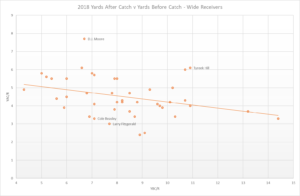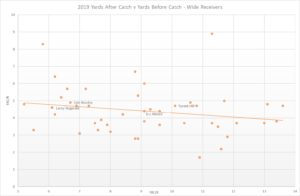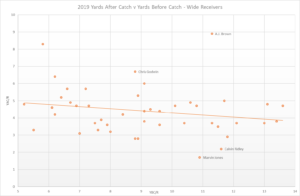Yards After Catch, Regression, and Why I’m Still Drafting AJ Brown
“YAC” is one of the favourite buzz-phrases of a fantasy analyst. So is “regression”. What happens when we put those together? We get to see the players that were unsustainably good after the catch, and those that were unsustainably bad. I looked at this to identify some players who we may not be looking at fairly right now.
What is YAC?
First things first, what is YAC? No, it’s not some kind of domesticated Ox! YAC is Yards After Catch and it’s as simple as it sounds. YAC is the yards that a player gets after he has caught the ball.
Many standard statistics show yards-per-target or yards-per-reception, but they take in to account how far the QB is throwing the ball, and so don’t really show a true reflection of how much the receiver is contributing to that play.
Exhibit A – In 2019 Cooper Kupp had a yards-per-target of 8.7. Marvin Jones had 8.6. Compare the two on this basis and you’d be forgiven for thinking that they’re getting similar production on their targets.
Now lets break it down in to yards-before-catch and yards-after-catch.
Before the catch, Kupp got 6.6 yards. Jones got 10.9 yards. Big difference.
After the catch, Kupp got 5.7 yards. Jones got 1.7 yards. In other words, Kupp caught the ball closer to the line of scrimmage and then made plays. Jones, on the other hand, got the ball thrown deeper and then did next-to-nothing with it once he caught it.
So you can see that splitting up the stats helps us see what’s really going on. But does it matter? If the ball goes 8.6/8.7 yards downfield and that receiver gets those yards on his stat-line (and more importantly on your fantasy points), surely that’s all that matters? Well, yes, sort of. You see, it matters when you look back at the end of the year to see how well the receivers performed. But when you’re looking forward and trying to predict what is going to happen next year, a simple yards-per-target or yards-per-reception has too many variables.
Exhibit B – in 2019, AJ Brown had 20.2 yards-per-reception. That’s massive, and significantly better than the rest of the wide receivers. He can’t sustain that, surely (at least that’s what the analysts say). But how do you predict the level to which that comes down? What if his QB is still throwing it the same distance to him, what if he gets the ball much shorter, what if he catches the ball less, etc. The most accurate way to do this is to look at each of those elements separately and take a reasonable assessment. We can predict how far his QB is going to throw the ball. We can predict how often he is going to catch those passes. And we can predict how many yards he puts up after he catches it.
What about Regression?
Ah, regression. The fruits of many twitter debates between fantasy football heads and those with enough confidence in their English language skills to say that positive regression should be called progression.
Let’s get that cleared up first. Regression is a statistical term and is all about getting back to the most likely outcome (the mean). There may be a statistical outlier that is unlikely to be repeated (that’s statistics folks) and so is expected to be much closer to the ‘likely’ outcome next time around. If you flip a coin 10 times in a row and you get 10 heads, you’d probably expect the next 10 flips to come much closer to a 50/50 split between heads and tails. That’s statistical regression.
If the previous performance was higher than the mean, then it is likely to negatively regress towards that mean. If it was lower, then it is likely to positively regress towards that mean.
Got it? Good.
2018 to 2019
A proof case. If we look at the outliers from 2018, we see a few key names. On the high side, we have DJ Moore and Tyreek Hill. On the low side, we have Larry Fitzgerald and Cole Beasley.
One thing you’ll notice with these graphs is that the expected YAC changes depending on the depth of the catch. This is logical when you think about. A deeper throw spends more time in the air, which gives more time for defensive backs to be in the same place as the receiver when they catch the ball, and therefore less chance for that receiver to make a significant play once they do (think Mike Evans taking a contested catch in double-coverage). If a receiver gets separation closer to the line of scrimmage and the ball is out to them quick, they have a greater chance of making a play before a defender can get to them.
How did these four example players fare in 2019?
As you can see, those four players are much closer to that trendline in 2019. In other words, they regressed closer to the mean. And it would have been wise not to predict their 2019 performance based on their 2018 performance. If you had predicted their YAC to be closer to the mean, you would have been much closer to predicting their final outcome.
The Outliers for 2019
If we look at some of the outliers from 2019, we can start identifying the targets for YAC regression.
For the sake of your eyes, I’ve once again removed a lot of the names and left a few key names to take a look at.
AJ Brown
By all measures, AJ Brown’s performance last year was impressive, particularly when you look at the number of targets he got. Brown and Stefon Diggs were the only wide receivers to get over 1,000 yards on less than 100 targets.
His YAC – 8.9 yards per reception. Deebo Samuel was the only other player to get close to this and his depth of target was MUCH closer to the line of scrimmage, his was the Kyle Shanahan playbook effect. After that, the next guy down (Chris Godwin) got 6.7, and you’ll see from the chart above that he is an outlier himself. In 2018, the highest was 7.7.
Related | Why Yards After Catch Monsters AJ Brown & DJ Moore Are Now Top-5 Dynasty WRs
So AJ Brown ’s yards after catch has to come down, right? Absolutely it does. But lets be clear, Brown’s YAC can regress significantly and still be an outlier. Regression is about getting closer to the mean, it’s not necessarily about getting all the way. Based on his depth of catch, the mean YAC would be 4.1 yards, that’s less than half of what he got in 2019 and it seems incredibly unlikely that his abilities and talent tumble that dramatically. And his depth of catch was high, so there’s every chance that comes down.
See Where Yards After Catch Monster AJ Brown Lands In Our 2020 Wide Receiver Rankings!
Look back at the graph, the stats say that if the depth of catch gets lower, the YAC is likely to get higher! So it’s completely reasonable to start by bringing AJ Brown ‘s yards after catch expectations down somewhat, then projecting him for a shorter depth of catch, and then putting that YAC back up as a result. Whichever way you cut this, whatever reasonable regression you give this guy’s YAC, those numbers are going to stay high.
Marvin Jones
 On the other side of the line, Marvin Jones had a much lower YAC than you’d expect from his depth of catch. In fact when you compare him to AJ Brown, their depth of target was similar and look at the difference!
On the other side of the line, Marvin Jones had a much lower YAC than you’d expect from his depth of catch. In fact when you compare him to AJ Brown, their depth of target was similar and look at the difference!
Based on that depth of target, the expected YAC for Jones would have been 4.2 yards per reception. He got 1.7. That’s low and you can definitely expect that to head back towards the mean in 2020.
Related | Why Marvin Jones Is A Great Buy For Any Dynasty Contender
Calvin Ridley
A similar story with Ridley, with a YAC of 2.2 yards per reception against an expected 4.1 yards. He seems to be on every analyst’s list to be this year’s Chris Godwin but if he’s going to do that, his YAC needs to get back towards that mean, and there’s plenty of scope for that to happen.
Chris Godwin
Talking of Chris Godwin, let’s finish with one of the 2019 high performers. As you can see from the chart, and as touched on briefly above, Godwin is way above the line. His YAC was high. If I look back at 2018, Godwin was almost exactly on the trendline and his YAC was exactly as it would be expected to be.
Yes he made a leap in 2019, he’s good! But, unlike Brown, his depth of catch wasn’t excessive and he doesn’t have that combination of high catch depth and high YAC. So he doesn’t have the same scope for increasing his YAC through a significant reduction in catch depth. Godwin is still a great receiver and he now has one of the best in the history of the game throwing him the ball (don’t start Twitter….), but the numbers tell us that we can expect that YAC rate to come back down to earth in 2020.
Summary
YAC is not the one true stat to rule all stats. YAC alone should not create your rankings and tell you who to draft. But it’s important to understand what it is, what it means and that those monster receivers who could not be brought down are likely to come back to the pack in 2020…unless you’re AJ Brown that is.










